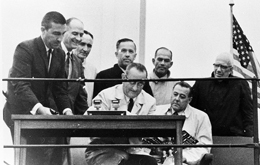On September 15, 1964, the 1964 Pacific Northwest Coordination Agreement to manage power and water on the Columbia River system is signed by 16 regional power entities. This agreement is a crucial element of the Columbia River Treaty between the U.S. and Canada, since the treaty "assumes coordination among the producers of power in the Pacific Northwest" (Pacific Northwest Coordination Agreement). It is an extension of three previous coordination agreements among members of the Northwest Power Pool -- which interconnects the region's diverse electrical systems -- in 1961, 1962 and 1963, but this one is far more comprehensive and is specified to last for 39 years. One day after the Coordination Agreement is signed at Seattle's Olympic Hotel, President Lyndon B. Johnson (1908-1973) and Prime Minister Lester Pearson (1897-1972) will join in a formal Columbia River Treaty signing ceremony at the Peace Arch on the Canadian border in Blaine.
Principles of Coordination
The existing 1909 Boundary Waters Treaty between the U.S. and Canada provided for an International Joint Commission to deal with Columbia River water-storage and power-generation issues, which were now becoming vastly more complicated. In 1961, after two decades of negotiations, the International Joint Commission delivered a new draft treaty called the Columbia River Treaty. It was controversial in Canada and Canada's Parliament did not ratify it that year. As further negotiations continued, a contingent of Northwest utilities in the Northwest Power Pool worked to include stronger principles of coordination to manage the Columbia River system. It had also become clear that one unified stateside entity would be required, so that Canada would not have to deal with dozens of separate U.S. utilities. The Northwest utilities got together and compiled a list of 13 principles, which served as a kind of blueprint for joint management of the river and also codified many of the informal "handshake" agreements that had previously existed between the various Power Pool entities. Most of the responsibility for compiling and analyzing the data used in the agreements fell to the Northwest Power Pool, mainly because that organization had developed a state-of-the-art computer program for these kinds of studies. So in 1961 the utilities signed the 1961-1962 Pacific Northwest Coordination Agreement, based largely on the 13 principles. Similar agreements were then signed in 1962 and 1963.
In 1964, as Columbia River Treaty negotiations neared fruition, it was more important than ever to spell out these river and power management principles, since "the treaty contemplates that, regardless of diverse ownerships, U.S. projects benefiting from Canadian storage will be operated to make the maximum use of that storage [and] Canada's half of treaty power benefits is computed on the assumption this will be done" ("1964 Report," p. 10). Clearly, before the treaty was signed a new Pacific Northwest Coordination Agreement was necessary that would extend for many years. Early in 1964, the Northwest entities began negotiating a truly long-term Coordination Agreement. Details were hashed out over the spring and summer.
The Agreement
The final version was 53 pages long. Its intent was summarized in a preamble that said:
"Whereas, the parties hereto operate major electric plants and systems which serve the Pacific Northwest area and have in the past voluntarily cooperated in the coordinated operation of their facilities through the Northwest Power Pool ... and have thereby achieved substantial economies and additional firm power resources for the Pacific Northwest; and Whereas, coordination for the production of power must take into consideration non-power uses for water resources and must be achieved as a part of the comprehensive development and management of water resources for maximum sustained benefit for the public good; and Whereas, the United States of America and Canada have entered into the [Columbia River Treaty], which Treaty assumes coordination among the producers of power in the Pacific Northwest and the Canadian facilities subject to the Treaty" (Pacific Northwest Coordination Agreement).
A conference paper written later that year summarized the agreement's contents:
"It follows a pattern established by principles agreed to in 1961. It contains many features for the operation and planning for operation of a hydroelectric power system. Original concepts are represented by energy content curves, in-lieu energy, computation of reservoir payments and allocation of forced outage reserves" (Jolliffe, Mohler, Dean).
A 2001 federal publication described it like this:
"The Coordination Agreement calls for annual planning, which must accommodate all the authorized purposes of the Columbia River hydro projects. It establishes processes that coordinate the use of planned Canadian storage operations with Federal and non-Federal project operations in the Northwest. The Coordination Agreement enables the region's power producers to optimize system reliability and power production after giving priority to non-power objectives. It recognizes project and system requirements that are frequently changing to serve multiple river uses. Individual project owners set the requirements for using their own reservoirs" (The Columbia River System, 23).
Gerry Garman of Seattle City Light said in 2015, "It basically laid out how you were going to manage the water resources, recognizing that we were dealing with a really good, cheap power supply -- but unpredictable" (Garman interview). The agreement was finished and signed just one day before the official Columbia River Treaty signing ceremony. Merrill Schultz, a BPA engineer, recalled the signing, on September 15, 1964, at Seattle's Olympic Hotel ballroom, as "a mass execution of contracts ... the tables were stacked high with contracts" (Schultz interview).
The signatories to the 1964 Pacific Northwest Coordination Agreement were BPA, the U.S. Army Corps of Engineers, Grant County PUD, Chelan County PUD, the Pend Oreille County PUD, the Douglas County PUD, Cowlitz County PUD, Puget Sound Power and Light, Portland General Electric, Pacific Power & Light, Washington Water Power, Montana Power, the Colockum Transmission Co. (near Quincy in Grant County), and the cities of Eugene, Seattle and Tacoma. The agreement was revised in 1997.

